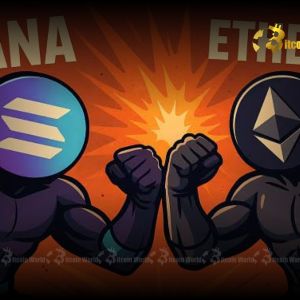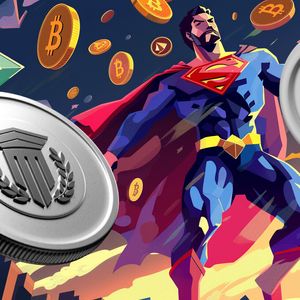Solana’s Surprising Resilience: Why SOL/ETH Ratio Hits Alarming Lows Despite Massive Capital Inflows
9 min read
BitcoinWorld Solana’s Surprising Resilience: Why SOL/ETH Ratio Hits Alarming Lows Despite Massive Capital Inflows The cryptocurrency market is a realm of constant surprises, and recent data has presented a fascinating paradox: Solana (SOL) ’s performance relative to Ethereum has plummeted to a yearly low, even as the network attracts a staggering amount of new capital. This intriguing development challenges conventional wisdom and prompts a deeper dive into the underlying dynamics of two of the industry’s leading smart contract platforms. Understanding the Declining SOL/ETH Ratio: What Does it Mean? When investors and analysts discuss the health and relative strength of different blockchain ecosystems, ratios like the SOL/ETH Ratio become crucial indicators. This specific metric measures Solana’s market capitalization or price performance directly against that of Ethereum. A declining ratio suggests that, over a given period, Solana has underperformed Ethereum. According to a recent update from the esteemed on-chain market intelligence platform Glassnode, this ratio has seen a significant drop from its April peak of 0.0868 to a current low of 0.0586, marking one of its lowest points this year. This movement is particularly noteworthy because it presents a seemingly contradictory narrative to other positive indicators for Solana. What does this declining ratio truly tell us? It indicates a shift in investor preference or perception, where despite Solana’s impressive growth, Ethereum is currently holding its ground or gaining relative strength. This isn’t necessarily a bearish signal for Solana in isolation, but rather a comparative performance indicator that warrants closer examination. It raises questions about market sentiment, liquidity dynamics, and the long-term positioning of these two blockchain giants. The Enigma of Surging Crypto Capital Inflows for Solana Adding another layer of intrigue to this market puzzle is the substantial difference in recent crypto capital inflows into these two networks. While the SOL/ETH Ratio has been on a downward trend, Solana has paradoxically outpaced Ethereum in attracting fresh investment. Over the past week alone, Solana witnessed a staggering $8.3 billion in new capital inflows. In comparison, Ethereum, the reigning king of smart contracts, secured $6.2 billion during the same period. This data, also highlighted by Glassnode, underscores a critical divergence: investors are clearly deploying significant new funds into the Solana ecosystem, even as its relative value against Ethereum seems to wane. This surge in capital for Solana isn’t just a fleeting moment; it speaks to a growing confidence among a segment of investors in the network’s potential. It suggests that despite the comparative underperformance indicated by the ratio, the absolute flow of money into Solana remains robust. This inflow can be attributed to various factors, including the launch of new projects, heightened trading activity, and a general bullish sentiment surrounding certain aspects of the Solana ecosystem. What’s Fueling Solana (SOL)’s Magnetic Appeal? So, if the SOL/ETH Ratio is declining, why are investors pouring so much capital into Solana (SOL) ? The answer lies in several compelling factors that make Solana a highly attractive destination for decentralized applications and new capital. Solana’s architecture is renowned for its high transaction throughput and remarkably low transaction fees, addressing some of the scalability challenges that have historically plagued other blockchains. This technical prowess has fostered a vibrant and rapidly expanding ecosystem. Key drivers behind Solana’s recent surge in capital inflows include: Explosive Meme Coin Activity: Solana has become the preferred blockchain for launching new meme coins, attracting a wave of speculative capital and retail interest. The low fees make frequent trading feasible, fueling a high-velocity market. Growing DeFi and NFT Landscape: Beyond meme coins, Solana’s decentralized finance (DeFi) sector continues to mature, offering a range of lending, borrowing, and trading protocols. Its NFT market also remains active, drawing creators and collectors alike. Developer Momentum: The Solana developer community is expanding, with numerous hackathons and grants encouraging innovation. New projects in areas like DePIN (Decentralized Physical Infrastructure Networks) and gaming are choosing Solana for its performance capabilities. Strategic Partnerships and Integrations: Solana continues to forge partnerships and integrate with various Web2 and Web3 entities, enhancing its utility and reach. These elements collectively paint a picture of a dynamic and innovative ecosystem that, despite comparative price action against Ethereum, is generating significant excitement and drawing substantial investment. The narrative for Solana often centers around its potential to onboard the next billion users due to its speed and cost-efficiency. Analyzing Ethereum (ETH)’s Capital Dynamics: Still the King? While Solana has been making headlines with its capital inflows, it’s essential to analyze the context of Ethereum (ETH) . Ethereum remains the bedrock of the decentralized web, boasting the largest and most established ecosystem for DeFi, NFTs, and decentralized applications. Its security, decentralization, and robust developer community are unparalleled. The recent Dencun upgrade further enhanced its scalability through ‘proto-danksharding,’ making Layer 2 solutions even more efficient. So, why did Ethereum attract “only” $6.2 billion in new capital compared to Solana’s $8.3 billion in the same week? Several factors could be at play: Maturity and Market Saturation: Ethereum is a more mature network. While it continues to grow, the explosive growth phase that attracts massive new speculative capital might have shifted to newer, higher-beta alternatives like Solana. Focus on Institutional Adoption: Ethereum’s trajectory often involves more institutional and long-term capital, which might not always manifest as rapid, high-volume inflows on a weekly basis compared to the retail-driven flows seen in meme coin ecosystems. Gas Fees: While Layer 2s mitigate this, direct interactions on the Ethereum mainnet can still incur higher gas fees, potentially deterring some retail activity that might gravitate towards Solana’s lower-cost environment. Staking Dominance: A significant portion of ETH is locked in staking, reducing circulating supply and perhaps slowing down the velocity of new capital entering the market for immediate trading purposes. It’s crucial to understand that lower weekly capital inflows for Ethereum do not equate to a decline in its fundamental strength or long-term value proposition. Ethereum continues to be the foundational layer for countless innovations, and its network effects are incredibly powerful. The comparison here is about new money entering, rather than overall market dominance or fundamental value. What Does Glassnode’s On-Chain Data Truly Reveal Beyond the Surface? The insights provided by Glassnode, a leading platform for on-chain data , are invaluable for understanding the nuanced dynamics of the crypto market. While the SOL/ETH Ratio and capital inflows are headline figures, digging deeper into other on-chain metrics can paint a more complete picture of network health and activity. Beyond the raw capital inflow numbers, Glassnode’s analysis often includes: Active Addresses: Are more unique users interacting with the network? A rise in active addresses for Solana, for instance, would corroborate the capital inflow narrative, indicating genuine user adoption. Transaction Counts: High transaction volumes, especially for Solana, would highlight its utility as a high-throughput blockchain, processing numerous small transactions, often related to meme coins or gaming. Total Value Locked (TVL): While not directly mentioned, TVL in DeFi protocols on both chains indicates the amount of capital locked within their respective decentralized applications. A growing TVL for Solana would align with its capital inflow, while Ethereum’s TVL remains dominant. Stablecoin Flows: The movement of stablecoins (USDT, USDC) on a blockchain often indicates liquidity and trading activity. Significant stablecoin inflows onto Solana could explain the rapid capital deployment. The Glassnode update, by highlighting the SOL/ETH ratio alongside capital inflows, prompts us to look beyond simple price action. It encourages a holistic view, where seemingly contradictory data points might, in fact, reveal complex market behaviors. The capital inflows into Solana suggest a strong belief in its future utility and growth potential, even if its relative performance against Ethereum is currently facing headwinds. The Paradox Unpacked: Reconciling Low Ratio with High Inflows The core of this market conundrum lies in reconciling the seemingly contradictory data points: a declining SOL/ETH Ratio versus Solana’s superior crypto capital inflows . How can a network attract more money yet underperform its key competitor on a relative basis? Here are a few hypotheses to explain this fascinating paradox: Type of Capital: The capital flowing into Solana might be predominantly speculative and short-term, driven by the rapid turnover of meme coins and high-velocity trading. This kind of capital can inflate transaction volumes and attract headlines, but it doesn’t always translate into sustained, fundamental price appreciation relative to a more established asset like Ethereum, which tends to attract longer-term, institutional, and foundational capital. Market Cap Disparity: Ethereum’s market capitalization is significantly larger than Solana’s. For Solana to make a noticeable dent in the SOL/ETH Ratio , it would require an even more substantial percentage increase in its market value compared to Ethereum. A large absolute capital inflow into a smaller market cap asset might still not be enough to shift the ratio dramatically if the larger asset also sees steady, albeit smaller, percentage growth. Profit-Taking and Rotation: Investors who saw significant gains from Solana’s previous rallies might be taking profits, or rotating some of their SOL holdings into ETH, which is often perceived as a more stable store of value within the altcoin space. This profit-taking could depress the SOL/ETH ratio even as new money flows into the ecosystem for other purposes. Liquidity and Depth: Ethereum’s market is far deeper and more liquid. Even if Solana sees high inflows, the sheer volume of trading pairs and liquidity on Ethereum might absorb new capital more efficiently without drastic price movements relative to SOL. Ultimately, the ratio reflects the market’s collective valuation of Solana relative to Ethereum. While capital inflows show interest and activity , the ratio indicates comparative strength in terms of investment returns. The paradox suggests a complex interplay between speculative fervor, fundamental utility, and long-term investor sentiment. Actionable Insights and Future Outlook: Navigating the SOL vs. ETH Landscape Understanding the intricate dance between SOL/ETH Ratio , crypto capital inflows , and the underlying dynamics of Solana (SOL) and Ethereum (ETH) offers valuable insights for both investors and developers. This analysis isn’t about declaring a “winner” but rather understanding the diverse strengths and challenges of each network. For Investors: Diversification is Key: The fluctuating ratio highlights the importance of not putting all your eggs in one basket. Both Solana and Ethereum offer distinct value propositions. Understand Risk Profiles: Solana, with its rapid growth and higher volatility (often associated with meme coin activity), might appeal to those with a higher risk tolerance. Ethereum, while still volatile, is generally considered a more established and foundational asset. Look Beyond Headlines: While capital inflows are positive, dig into the type of capital and its sustainability. On-chain data from platforms like Glassnode provides deeper context. Long-Term vs. Short-Term: Consider your investment horizon. Ethereum’s long-term thesis often revolves around its foundational role and institutional adoption, while Solana’s might be about rapid user growth and new use cases. For Developers: Choose Wisely Based on Use Case: Solana offers unparalleled speed and low costs for applications requiring high transaction volumes (e.g., gaming, high-frequency DeFi). Ethereum, especially with its Layer 2 ecosystem, provides robust security, decentralization, and a vast developer toolset for more complex, high-value applications. Multi-Chain Future: The market is clearly moving towards a multi-chain future where different blockchains excel at different things. Understanding the strengths of both Solana and Ethereum will be crucial for building resilient and scalable dApps. The current market dynamics underscore the fact that the cryptocurrency space is constantly evolving. While the SOL/ETH Ratio might currently favor Ethereum, Solana’s ability to attract significant new capital cannot be ignored. This ongoing competition and innovation between leading networks ultimately benefits the entire crypto ecosystem, pushing the boundaries of what’s possible in decentralized technology. Conclusion: A Dynamic Duopoly Shaping the Future In conclusion, the recent Glassnode update presents a compelling paradox: a declining SOL/ETH Ratio juxtaposed against Solana’s (SOL) impressive lead in crypto capital inflows over Ethereum (ETH) . This scenario highlights the multifaceted nature of the digital asset market, where raw investment numbers don’t always tell the whole story of relative performance. While Solana continues to attract significant new money, likely driven by its high-performance capabilities and vibrant meme coin ecosystem, Ethereum maintains its fundamental strength and attracts a different kind of capital. The insights derived from on-chain data are critical for navigating these complex market dynamics. They remind us that the crypto market is not monolithic; different chains serve different purposes and attract different types of participants. As both Solana and Ethereum continue to evolve, their interplay will undoubtedly shape the future of decentralized finance and the broader Web3 landscape. Investors and enthusiasts alike must look beyond singular metrics and embrace a holistic view to truly understand the pulse of this exciting and ever-changing industry. To learn more about the latest crypto market trends, explore our article on key developments shaping Ethereum and Solana price action. This post Solana’s Surprising Resilience: Why SOL/ETH Ratio Hits Alarming Lows Despite Massive Capital Inflows first appeared on BitcoinWorld and is written by Editorial Team

Source: Bitcoin World



